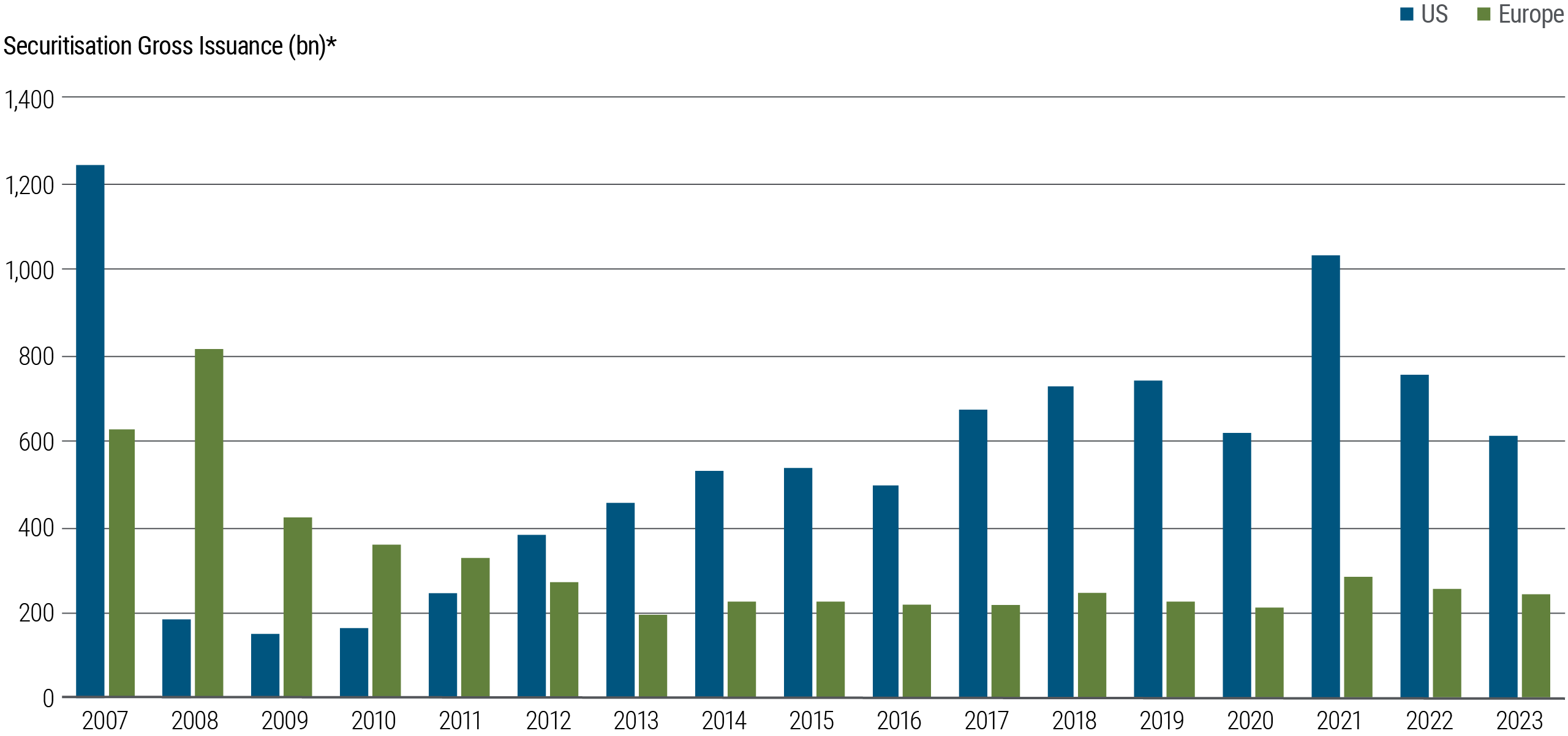


The EU securitisation market has transformed significantly over the past 15 years, driven predominantly by regulatory change. But some of these developments may have impeded investment opportunities, and we believe changes to regulation should be made to both maintain quality and promote growth in issuance of securitisations in the EU.
Post-GFC regulations have contributed to a reduction in issuance and fewer investment opportunities in the European securitisation markets over the past decade (Figure 1). In the aftermath of the US subprime mortgage crisis, and the subsequent near-collapse of the European banking system, EU legislators and regulators understandably and appropriately addressed the root causes of the GFC. These include significant embedded leverage, poor diversification, and risky underlying lending practices across securitisation markets.
Because of these regulatory changes, the EU securitization market has experienced improved loan-level diversification, significantly lower default rates, and much higher lending standards. But 15 years on from the GFC, market participants, legislators, and regulators have started to realise that certain aspects of the regulation are too challenging for securitisations to act as an effective credit channel in the EU.
Securitisation markets offer significant benefits to fixed income investors. They add diversification to the corporate credit risk typically held in fixed income portfolios, tend to generate an attractive level of yield per unit of risk, and have historically provided a low default rate for investors senior in the capital structure. Securitisations also benefit financial markets overall, as they inject capital into the economy to stimulate growth, and allow banks to transfer loan exposures to money managers. This frees up bank capital to make additional loans to consumers, real estate investors, and companies.
While PIMCO and the broader financial markets tend to see many of the post-GFC changes as positive developments in the securitisation space, we also recognise a secondary effect of some of this post-GFC regulation. EU securitisation issuance remains well below pre-crisis highs, while US issuance has seen continued growth. European institutional investors, such as UCITS funds (Undertakings for Collective Investment in Transferable Securities), were already constrained by stringent requirements (such as a limit on acquiring more than 10% of the debt securities of a single issuing body), but have had their opportunity to invest in issuance further hampered by an inability to access high quality non-EU securitisation markets. These secondary effects suggest that some of the post-GFC regulatory changes in Europe have gone too far, stifling the market, impeding liquidity, and limiting investment and credit diversification opportunities for European institutional investors.
In this Viewpoint, we highlight specific aspects of post-GFC EU regulation that we believe have gone above and beyond what was necessary to strengthen the underlying quality of the European securitisation market and have therefore restricted investment opportunities. We also describe specific changes to regulation that could uphold quality and help grow the EU securitisation market.
BENEFITS FOR THE WIDER ECONOMY AND INVESTORS
Securitisations provide an opportunity for banks to transfer the credit risk of their assets to other investors, freeing up bank capital for lending to consumers and corporate borrowers. By broadening banks’ capacity to lend, securitisations act as an important credit channel, providing borrowers with competitive rates while spurring economic growth. Further, the underlying loans in a securitisation are often in the consumer credit space, thereby providing additional diversification for investors who would otherwise be predominantly exposed to corporate credit risk.
Securitisation deals are commonly sold in tranches, offering varying degrees of credit risk and return and facilitating a more efficient transfer of risk. This means that more risk-averse, high-quality-focused market participants have the opportunity to invest in loss-remote but lower-returning senior tranches, while more opportunistic and sophisticated investors have the opportunity to invest in higher-returning, first-loss, and subordinated tranches.
REGULATORY CHANGES FOLLOWING THE GFC
Prior to the GFC, the simple but overly bank-centric securitisation model had obvious shortcomings. For example, the complete transfer of risk from bank to investor created an incentive for banks to make riskier loans, which led to lower-quality, predatory loan practices, as well as poor loan-level diversification and significant overuse of leverage.
Post-GFC regulations have reconfigured the incentive structure. They have limited the practice of writing predatory loans, compelled banks to hold some amount of exposure to their securitisations, and halted the practice of layering securitisations to create excessive economic leverage in the market. This has resulted in a dramatic increase in the quality of underlying loans, a decline in US and EU defaults, and a stronger overall banking system (see Figure 2).
While the US and EU adopted these measures in the aftermath of the GFC – and have enjoyed similar levels of bank and securitisation quality since then – the US has continued to see a resurgence in securitisation issuance levels, while EU securitisation issuances have remained relatively low (see Figure 1).
That low issuance in the EU is not due merely to a lack of mortgages originated: If we examine the amount of residential mortgage-backed securities (RMBS) issuance as a percentage of new mortgage originations in the EU, we see a similar decline post-GFC (see Figure 3). We believe additional regulatory measures (in particular, a requirement for the EU originator, sponsor, or issuer of a securitisation to make available to investors detailed and prescriptive information on the underlying exposures of the securitisation, known as the EU Transparency Requirements) have made a significant contribution to the reduction in securitisation issuances in the EU.
Moreover, the EU regulatory requirements are broadly dual-sided. For example, not only do EU originators, sponsors, and issuers of a securitisation need to comply with the EU Transparency Requirements, but EU institutional investors (including UCITS funds and pension funds) need to ensure compliance with these requirements too. However, significant challenges arise when an EU institutional investor wants to invest in a third country securitisation, i.e. a securitization where none of the origination, sponsor, or issuer are EU entities. In this scenario, investors must ensure they receive information that complies with the EU Transparency Requirements – despite those originators having no regulatory obligation to adhere to such requirements in their local jurisdictions. Typically, non-EU originators, sponsors, and issuers do not voluntarily provide information that complies with the EU Transparency Requirements. As a result, EU institutional investors are effectively prohibited from investing in these non-EU securitisations, putting them at a disadvantage versus their US peers.
The effects of the EU Securitisation Regulations have a particularly unfortunate adverse impact on individual investors. Such investors tend to gain market exposure through UCITS funds, which offer daily liquidity and efficient access to a diversified portfolio of assets. Even before the GFC, the UCITS rules prohibiting the acquisition of more than 10% of the debt securities of a single issuing body limited the ability of UCITS funds to effectively invest in securitisations. While this exposure limit applies to both corporate credit and securitisations alike, the two are not directly comparable. This is because securitisations tend to be significantly smaller, limiting the ability for UCITS to gain adequate exposure to an issue, despite the inherent diversification embedded in a securitisation. Further, the amortisation structure of a securitisation (compared with the bullet maturity structure of a typical corporate bond) means securitisation positions are shrinking, exacerbating these sizing constraints. This can lead to undersize positions in portfolios.
It also means that fund managers are typically forced to focus on newer, less attractive issues with larger deal sizes, instead of older, smaller issues that typically have more loan seasoning and thus more attractive cash flow profiles. In addition, the goal of this rule – to prevent a UCITS fund having too much exposure to a single issuer – is counterproductive given the structure of securitisations themselves, which, by their nature, are fully secured by diversified pools of underlying loans. The post-GFC regulatory environment has been burdensome for EU-compliant issuance. When combined with the existing limitation on deal exposure for UCITS funds, this means individual investors are frequently underexposed to high quality, seasoned collateral via securitisations, and overexposed to corporate credit risk in their “diversified” bond funds.
WHAT EU LEGISLATORS AND REGULATORS CAN DO TO INCREASE OPPORTUNITIES WHILE MAINTAINING QUALITY
PIMCO has been an investor in securitisations for more than 50 years, and we have proved time and again our ability to navigate the complexities of these markets to provide opportunities for our clients, including millions of fund investors globally. This extensive and successful experience investing in securitised asset classes leads us to conclude that the current implementation of the EU Transparency Requirements unnecessarily penalises the many pensioners and other ordinary investors in UCITS funds, by depriving them of additional sources of returns and diversification. We believe that reform of the EU Transparency Requirements, in particular as they apply to non-EU securitisations, and alignment of the 10% issuer UCITS rule to the principles regulators seek to achieve, would expand opportunities for UCITS to produce higher returns for their investors, without raising UCITS’ risk profile.
To the extent that one purpose of the EU Transparency Requirements was to foster development of the EU securitisation market, that hasn’t been the result. History has shown that third country originators accessing the EU securitisation market has not evolved – and is unlikely to evolve – in a way that facilitates full compliance with the EU rules. The requirements have not only hindered banks and other participants in the EU securitisation market, they have negatively affected UCITS investors relative to investors in similar funds in other jurisdictions.
In this regard, we suggest that the EU recognise the robustness of the risk retention standards of securitisations issued in countries outside of the EU, together with a principles-based approach to the EU Transparency Requirements. The European Securities and Markets Authority (ESMA) is currently considering the responses to its recent consultation on the disclosure templates relating to the specific information and details of securitisation transactions that are required to be available. This represents an important opportunity to streamline and simplify the current prohibitively strict disclosure requirements applying to investment in non-EU securitisations. We would encourage ESMA to do so, and to modify aspects of the current requirements that have had adverse effects on EU investors and securitisation markets.




